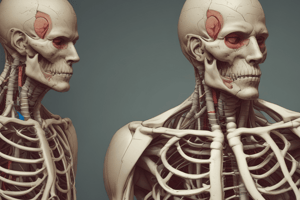Podcast
Questions and Answers
Which method is NOT typically used in the study of living anatomy?
Which method is NOT typically used in the study of living anatomy?
- Auscultation
- Palpation
- Genetics (correct)
- Radiography
Embryology is the study of postnatal development changes in an individual.
Embryology is the study of postnatal development changes in an individual.
False (B)
What is the term used to describe the developmental history of an individual?
What is the term used to describe the developmental history of an individual?
ontogeny
____ anatomy focuses on the anatomical knowledge applied in medical practice.
____ anatomy focuses on the anatomical knowledge applied in medical practice.
Match the following terms with their definitions:
Match the following terms with their definitions:
Which aspect of genetics mainly deals with chromosomal information?
Which aspect of genetics mainly deals with chromosomal information?
Radiographic anatomy is concerned only with the study of bones.
Radiographic anatomy is concerned only with the study of bones.
What is the purpose of surface anatomy?
What is the purpose of surface anatomy?
What does the term 'anatomy' mean?
What does the term 'anatomy' mean?
Anatomy and dissection are synonymous terms.
Anatomy and dissection are synonymous terms.
What is the primary difference between cadaveric anatomy and systemic anatomy?
What is the primary difference between cadaveric anatomy and systemic anatomy?
The term anatomy is derived from a Greek word meaning __________.
The term anatomy is derived from a Greek word meaning __________.
Match the following anatomical terms with their corresponding definitions:
Match the following anatomical terms with their corresponding definitions:
Which of the following is NOT a subdivision of anatomy?
Which of the following is NOT a subdivision of anatomy?
Anatomy serves as a foundation for the entire art of medicine.
Anatomy serves as a foundation for the entire art of medicine.
What study approach focuses on specific body parts such as the upper limb or thorax?
What study approach focuses on specific body parts such as the upper limb or thorax?
Flashcards are hidden until you start studying
Study Notes
Human Anatomy Overview
- Human anatomy studies the structure of the human body, derived from the Greek word "anatome," meaning cutting up.
- Dissection, a Latin term, refers specifically to a technique used in anatomical studies; it is distinct from anatomy as a broader field.
- Anatomy is foundational to medicine and introduces students to critical medical terminology.
- Anatomy is analogous to geography in relation to physiology as it provides the context for physiological functions.
Subdivisions of Anatomy
-
Cadaveric Anatomy: Study of dead, embalmed bodies through macroscopic examination.
- Approached via:
- Regional Anatomy: Investigates body parts (e.g., limbs, thorax, abdomen, head, neck, brain).
- Systemic Anatomy: Examines the body by systems, including:
- Skeletal (osteology)
- Muscular (myology)
- Articulatory (arthrology/syndesmology)
- Vascular (angiology)
- Nervous (neurology)
- Respiratory, digestive, urogenital, and endocrine systems (splanchnology).
- Approached via:
-
Living Anatomy: Involves examination of living subjects through techniques like inspection, palpation, and radiography.
-
Embryology: Focuses on prenatal developmental changes known as ontogeny, while phylogeny accounts for evolutionary history.
-
Histology: Microscopic study of structures, requiring the use of a microscope.
-
Surface Anatomy: Examines deeper body parts concerning the skin surface, useful in clinical practices and surgeries.
-
Radiographic and Imaging Anatomy: Investigates bones and deeper organs through techniques such as CT scans and ultrasound.
-
Comparative Anatomy: Compares anatomical structures across species to understand form, function, and structure variations in humans.
-
Physical Anthropology: Studies external features and measurements of various human races and prehistoric remains.
-
Applied Anatomy: Connects anatomical knowledge directly to medical and surgical practices.
-
Experimental Anatomy: Investigates factors influencing the form and function of body parts.
-
Genetics: Focuses on the study of chromosomal information and its implications for anatomy and physiology.
Studying That Suits You
Use AI to generate personalized quizzes and flashcards to suit your learning preferences.



